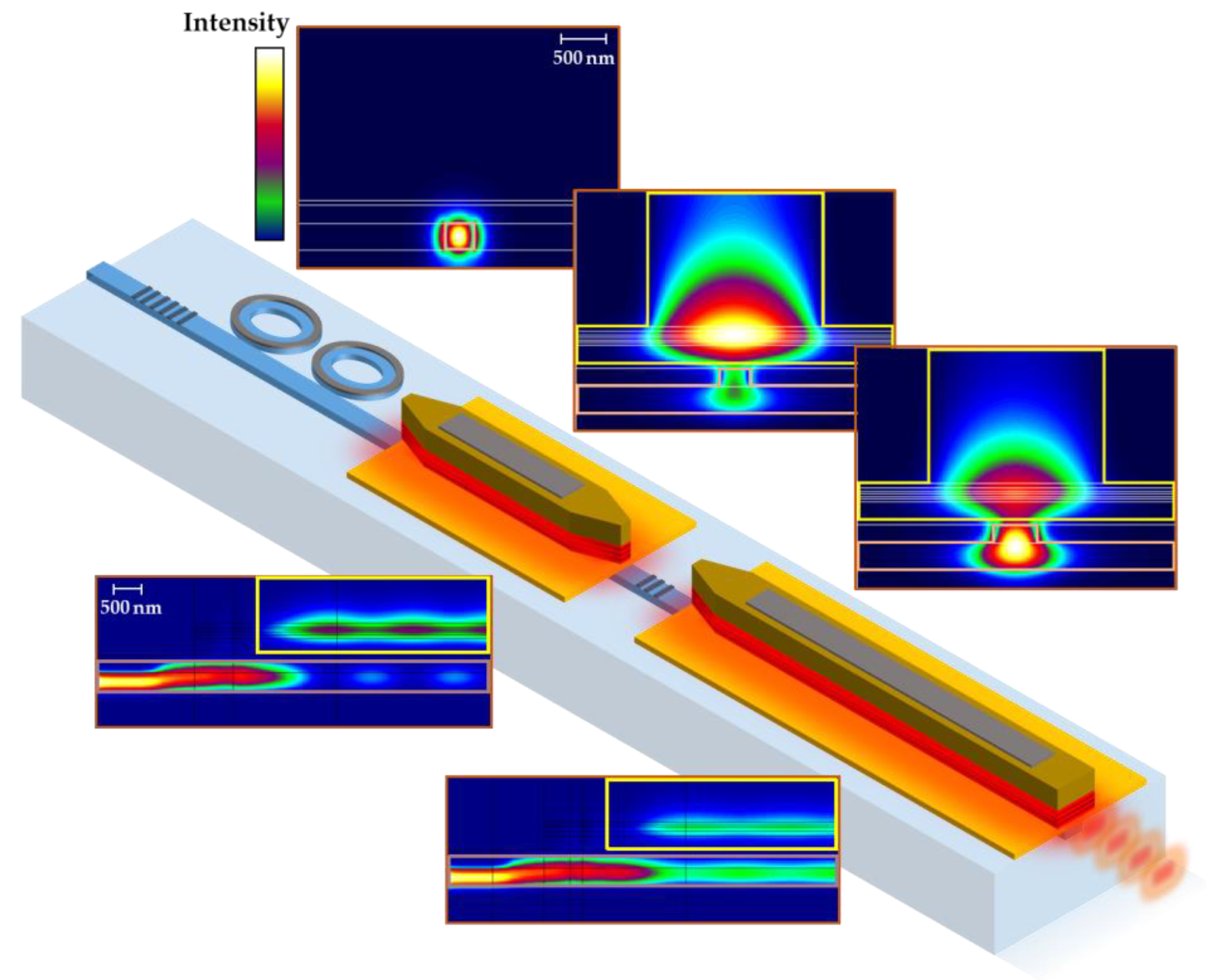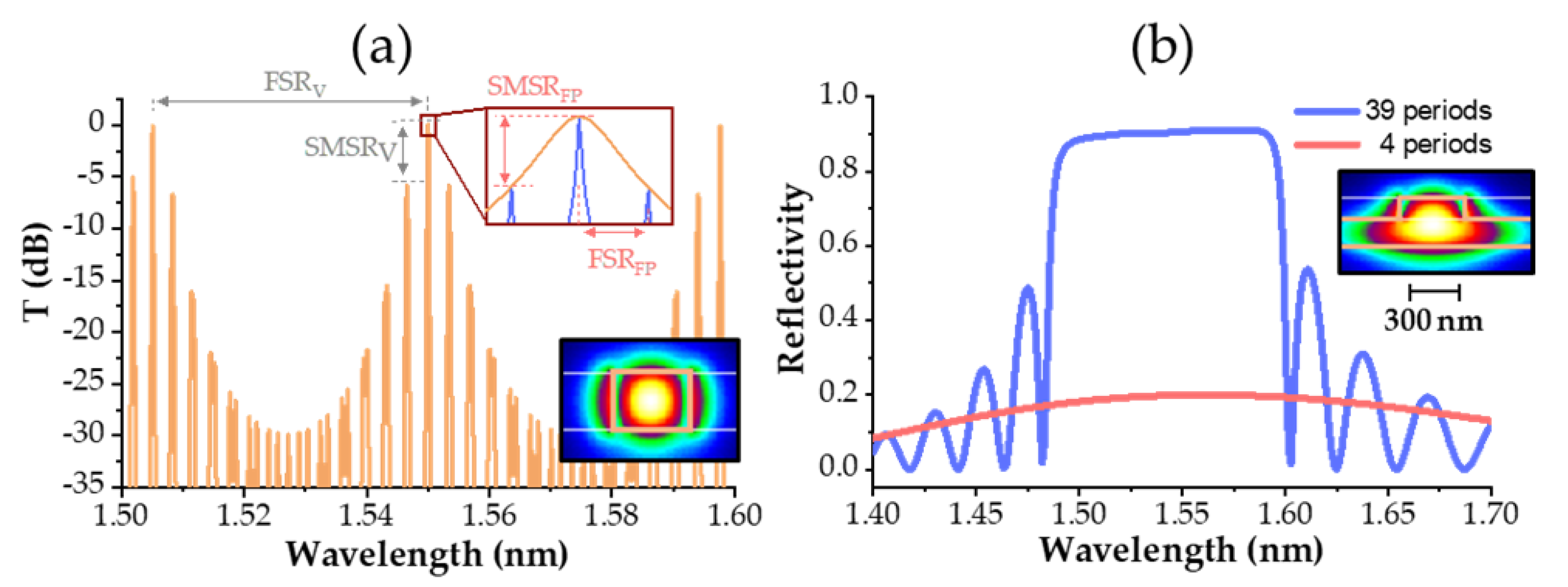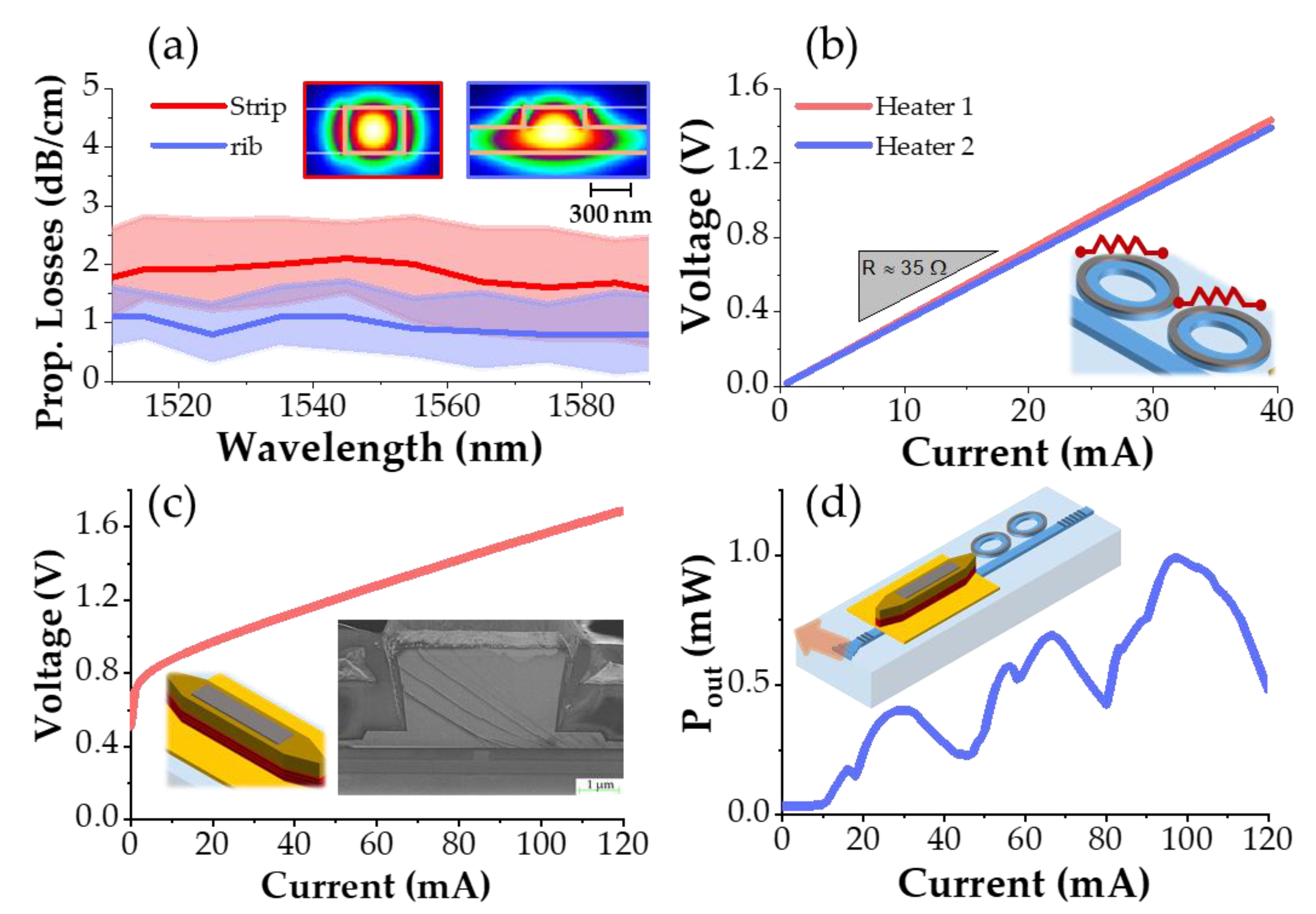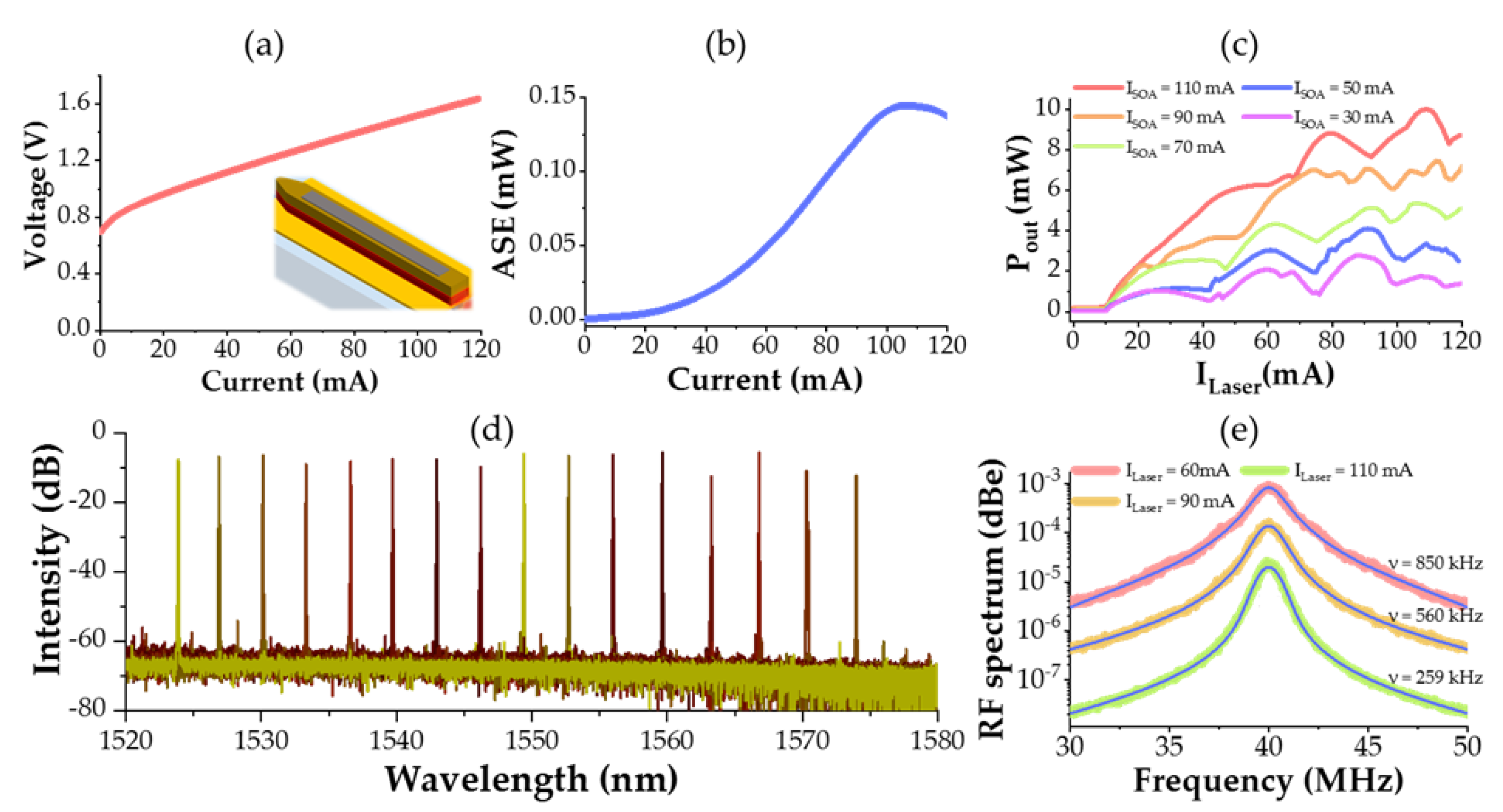Low-Threshold, High-Power On-Chip Tunable III-V/Si Lasers with Integrated Semiconductor Optical Amplifiers
Abstract
:Featured Application
Abstract
1. Introduction
2. Device Design and Structure
3. Experimental Results
4. Conclusions
Author Contributions
Funding
Institutional Review Board Statement
Informed Consent Statement
Data Availability Statement
Acknowledgments
Conflicts of Interest
References
- Roelkens, G.; Liu, L.; Liang, D.; Jones, R.; Fang, A.; Koch, B.; Bowers, J. III-V/silicon photonics for on-chip and intra-chip optical interconnects. Laser Photonics Rev. 2010, 4, 751–779. [Google Scholar] [CrossRef]
- Duan, G.-H.; Jany, C.; Le Liepvre, A.; Accard, A.; Lamponi, M.; Make, D.; Kaspar, P.; Levaufre, G.; Girard, N.; Lelarge, F.; et al. Hybrid III–V on Silicon Lasers for Photonic Integrated Circuits on Silicon. IEEE J. Sel. Top. Quantum Electron. 2014, 20, 158–170. [Google Scholar] [CrossRef] [Green Version]
- Marpaung, D.; Yao, J.; Capmany, J. Integrated microwave photonics. Nat. Photonics 2019, 13, 80–90. [Google Scholar] [CrossRef]
- Pérez, D.; Gasulla, I.; Crudgington, L.; Thomson, D.J.; Khokhar, A.Z.; Li, K.; Cao, W.; Mashanovich, G.Z.; Capmany, J. Multipurpose silicon photonics signal processor core. Nat. Commun. 2017, 8, 636. [Google Scholar] [CrossRef] [PubMed] [Green Version]
- Poulton, C.V.; Yaacobi, A.; Cole, D.B.; Byrd, M.J.; Raval, M.; Vermeulen, D.; Watts, M.R. Coherent solid-state lidar with silicon photonic optical phased arrays. Opt. Lett. 2017, 42, 4091–4094. [Google Scholar] [CrossRef] [PubMed]
- Xie, W.; Komljenovic, T.; Huang, J.; Tran, M.; Davenport, M.; Torres, A.; Pintus, P.; Bowers, J. Heterogeneous silicon photonics sensing for autonomous cars [Invited]. Opt. Express 2019, 27, 3642–3663. [Google Scholar] [CrossRef]
- Davenport, M.L.; Skendzic, S.; Volet, N.; Hulme, J.C.; Heck, M.J.R.; Bowers, J.E. Heterogeneous Silicon/III–V Semiconductor Optical Amplifiers. IEEE J. Sel. Top. Quantum Electron. 2016, 22, 78–88. [Google Scholar] [CrossRef]
- Tang, M.; Park, J.-S.; Wang, Z.; Chen, S.; Jurczak, P.; Seeds, A.; Liu, H. Integration of III-V lasers on Si for Si photonics. Prog. Quantum Electron. 2019, 66, 1–18. [Google Scholar] [CrossRef]
- Dong, P.; Chen, Y.-K.; Duan, G.-H.; Neilson, D.T. Silicon photonic devices and integrated circuits. Nanophotonics 2014, 3, 215–228. [Google Scholar] [CrossRef]
- Guo, X.; He, A.; Su, Y. Recent advances of heterogeneously integrated III–V laser on Si. J. Semicond. 2019, 40, 101304. [Google Scholar] [CrossRef]
- Ramirez, J.M.; Malhouitre, S.; Gradkowski, K.; Morrissey, P.E.; O’Brien, P.; Caillaud, C.; Vaissiere, N.; Decobert, J.; Lei, S.; Enright, R.; et al. III-V-on-Silicon Integration: From Hybrid Devices to Heterogeneous Photonic Integrated Circuits. IEEE J. Sel. Top. Quantum Electron. 2019, 26, 1–13. [Google Scholar] [CrossRef]
- Matsumoto, T.; Kurahashi, T.; Konoike, R.; Suzuki, K.; Tanizawa, K.; Uetake, A.; Takabayashi, K.; Ikeda, K.; Kawashima, H.; Akiyama, S.; et al. Hybrid-Integration of SOA on Silicon Photonics Platform Based on Flip-Chip Bonding. J. Light. Technol. 2018, 37, 307–313. [Google Scholar] [CrossRef]
- Verdier, A.; de Valicourt, G.; Brenot, R.; Debregeas, H.; Dong, P.; Earnshaw, M.; Carrère, H.; Chen, Y. Ultrawideband wavelength-tunable hybrid external-cavity lasers. J. Light. Technol. 2017, 36, 37–43. [Google Scholar] [CrossRef]
- Han, Y.; Yan, Z.; Ng, W.K.; Xue, Y.; Wong, K.S.; Lau, K.M. Bufferless 1.5 µm III-V lasers grown on Si-photonics 220 nm silicon-on-insulator platforms. Optica 2020, 7, 148–153. [Google Scholar] [CrossRef]
- Justice, J.; Bower, A.C.; Meitl, M.; Mooney, M.B.; Gubbins, M.A.; Corbett, B. Wafer-scale integration of group III–V lasers on silicon using transfer printing of epitaxial layers. Nat. Photonics 2012, 6, 610–614. [Google Scholar] [CrossRef]
- Zhang, J.; Muliuk, G.; Juvert, J.; Kumari, S.; Goyvaerts, J.; Haq, B.; Op De Beeck, C.; Kuyken, B.; Morthier, G.; Van Thourhout, D.; et al. III-V-on-Si photonic integrated circuits realized using micro-transfer-printing. APL Photonics 2019, 4, 110803. [Google Scholar] [CrossRef] [Green Version]
- Szelag, B.; Hassan, K.; Adelmini, L.; Ghegin, E.; Rodriguez, P.; Nemouchi, F.; Brianceau, P.; Vermande, E.; Schembri, A.; Carrara, D.; et al. Hybrid III–V/Silicon Technology for Laser Integration on a 200-mm Fully CMOS-Compatible Silicon Photonics Platform. IEEE J. Sel. Top. Quantum Electron. 2019, 25, 1–10. [Google Scholar] [CrossRef]
- Fang, A.W.; Park, H.; Cohen, O.; Jones, R.; Paniccia, M.J.; Bowers, J.E. Electrically pumped hybrid AlGaInAs-silicon evanescent laser. Opt. Express 2006, 14, 9203–9210. [Google Scholar] [CrossRef] [PubMed]
- Park, H.; Fang, A.W.; Cohen, O.; Jones, R.; Paniccia, M.J.; Bowers, J.E. A Hybrid AlGaInAs–Silicon Evanescent Amplifier. IEEE Photonics Technol. Lett. 2007, 19, 230–232. [Google Scholar] [CrossRef]
- Keyvaninia, S.; Verstuyft, S.; van Landschoot, L.; Lelarge, F.; Duan, G.-H.; Messaoudene, S.; Fedeli, J.M.; de Vries, T.; Smalbrugge, B.; Geluk, E.J.; et al. Heterogeneously integrated III-V/silicon distributed feedback lasers. Opt. Lett. 2013, 38, 5434–5437. [Google Scholar] [CrossRef] [Green Version]
- Kaspar, P.; De Valicourt, G.; Brenot, R.; Mestre, M.A.; Jennevé, P.; Accard, A.; Make, D.; Lelarge, F.; Duan, G.-H.; Pavarelli, N.; et al. Hybrid III-V/Silicon SOA in Optical Network Based on Advanced Modulation Formats. IEEE Photonics Technol. Lett. 2015, 27, 2383–2386. [Google Scholar] [CrossRef]
- Tran, M.A.; Huang, D.; Bowers, J.E. Tutorial on narrow linewidth tunable semiconductor lasers using Si/III-V heterogeneous integration. APL Photonics 2019, 4, 111101. [Google Scholar] [CrossRef] [Green Version]
- Yamaoka, S.; Diamantopoulos, N.; Nishi, H.; Nakao, R.; Fujii, T.; Takeda, K.; Hiraki, T.; Tsurugaya, T.; Kanazawa, S.; Tanobe, H.; et al. Directly modulated membrane lasers with 108 GHz bandwidth on a high-thermal-conductivity silicon carbide substrate. Nat. Photonics 2021, 15, 28–35. [Google Scholar] [CrossRef]
- Wan, Y.; Xiang, C.; Guo, J.; Koscica, R.; Kennedy, M.; Selvidge, J.; Zhang, Z.; Chang, L.; Xie, W.; Huang, D.; et al. High Speed Evanescent Quantum-Dot Lasers on Si. Laser Photonics Rev. 2021, 15, 2100057. [Google Scholar] [CrossRef]
- Jones, R.; Doussiere, P.; Driscoll, J.B.; Lin, W.; Yu, H.; Akulova, Y.; Komljenovic, T.; Bowers, J.E. Heterogeneously Integrated InP\/Silicon Photonics: Fabricating Fully Functional Transceivers. IEEE Nanotechnol. Mag. 2019, 13, 17–26. [Google Scholar] [CrossRef]
- Liang, D.; Labs, H.P.E.H.P.; Bowers, J.E. Recent Progress in Heterogeneous III-V-on-Silicon Photonic Integration. Light. Adv. Manuf. 2021, 2, 59–83. [Google Scholar] [CrossRef]
- Shang, C.; Wan, Y.; Selvidge, J.; Hughes, E.; Herrick, R.; Mukherjee, K.; Duan, J.; Grillot, F.; Chow, W.W.; Bowers, J.E. Perspectives on Advances in Quantum Dot Lasers and Integration with Si Photonic Integrated Circuits. ACS Photonics 2021, 8, 2555–2566. [Google Scholar] [CrossRef]
- Zhang, S.J.; Liu, Y.; Lu, R.G.; Sun, B.; Yan, L.S. Heterogeneous III–V silicon photonic integration: Components and characterization. Front. Inf. Technol. Electron. Eng. 2019, 20, 472–480. [Google Scholar] [CrossRef]
- Haq, B.; Kumari, S.; van Gasse, K.; Zhang, J.; Gocalinska, A.; Pelucchi, E.; Corbett, B.; Roelkens, G. Micro-Transfer-Printed III-V-on-Silicon C-Band Semiconductor Optical Amplifiers. Laser Photonics Rev. 2020, 14, 1900364. [Google Scholar] [CrossRef]
- Komljenovic, T.; Huang, D.; Pintus, P.; Tran, M.A.; Davenport, M.L.; Bowers, J.E. Photonic integrated circuits using heterogeneous integration on silicon. Proc. IEEE 2018, 106, 2246–2257. [Google Scholar] [CrossRef]
- Margalit, N.; Xiang, C.; Bowers, S.M.; Bjorlin, A.; Blum, R.; Bowers, J.E. Perspective on the future of silicon photonics and electronics. Appl. Phys. Lett. 2021, 118, 220501. [Google Scholar] [CrossRef]
- Bao, S.; Wang, Y.; Lina, K.; Zhang, L.; Wang, B.; Sasangka, W.A.; Lee, K.E.K.; Chua1, S.J.; Michel, J.; Fitzgerald, E. A review of silicon-based wafer bonding processes, an approach to realize the monolithic integration of Si-CMOS and III–V-on-Si wafers. J. Semicond. 2021, 42, 023106. [Google Scholar] [CrossRef]
- Zhao, B.; Chen, T.R.; Yariv, A. The extra differential gain enhancement in multiple-quantum-well lasers. IEEE Photonics Technol. Lett. 1992, 4, 124–126. [Google Scholar] [CrossRef] [Green Version]
- Morito, K.; Tanaka, S.; Tomabechi, S.; Kuramata, A. A broad-band MQW semiconductor optical amplifier with high saturation output power and low noise figure. IEEE Photonics Technol. Lett. 2005, 17, 974–976. [Google Scholar] [CrossRef]
- Arakawa, Y.; Yariv, A. Quantum well lasers–Gain, spectra, dynamics. IEEE J. Quantum Electron. 1986, 22, 1887–1899. [Google Scholar] [CrossRef] [Green Version]
- Coldren, L.A.; Corzine, S.W.; Mashanovitch, M.L. Diode Lasers and Photonic Integrated Circuits; John Wiley & Sons: Hoboken, NJ, USA, 2012; Volume 218. [Google Scholar]
- Keyvaninia, S.; Roelkens, G.G.; Van Thourhout, D.; Jany, C.; Lamponi, M.; Le Liepvre, A.; Lelarge, F.; Make, D.; Duan, G.-H.; Bordel, D.; et al. Demonstration of a heterogeneously integrated III-V/SOI single wavelength tunable laser. Opt. Express 2013, 21, 3784–3792. [Google Scholar] [CrossRef] [PubMed] [Green Version]
- Fowler, D.; Grosse, P.; Gays, F.; Szelag, B.; Baudot, C.; Vuillet, N.; Planchot, J.; Boeuf, F. Fiber grating coupler development for Si-photonics process design kits at CEA-LETI. In Smart Photonic and Optoelectronic Integrated Circuits XXI; International Society for Optics and Photonics: Bellingham, DC, USA, 2019; Volume 10922, p. 109225. [Google Scholar]
- Boller, Y.K.; van Rees, A.; Fan, Y.; Mak, J.; Lammerink, R.E.M.; Franken, C.A.A.; van der Slot, P.J.M.; Marpaung, D.A.I.; Fallnich, C.; Epping, J.P. Hybrid integrated semiconductor lasers with silicon nitride feedback circuits. Photonics 2020, 7, 4. [Google Scholar] [CrossRef] [Green Version]
- Van Gasse, K.; Wang, R.; Roelkens, G. 27 dB gain III–V-on-silicon semiconductor optical amplifier with >17 dBm output power. Opt. Express 2019, 27, 293–302. [Google Scholar] [CrossRef] [Green Version]
- Dawson, J.W.; Park, N.; Vahala, K.J. An improved delayed self-heterodyne interferometer for linewidth measurements. IEEE Photonics Technol. Lett. 1992, 4, 1063–1066. [Google Scholar] [CrossRef] [Green Version]
- Vahala, K.; Yariv, A. Detuned loading in coupled cavity semiconductor lasers—Effect on quantum noise and dynamics. Appl. Phys. Lett. 1984, 45, 501. [Google Scholar] [CrossRef] [Green Version]
- Sorin, W.; Chang, K.; Conrad, G.; Hernday, P. Frequency domain analysis of an optical FM discriminator. J. Light. Technol. 1992, 10, 787–793. [Google Scholar] [CrossRef]
- Le Liepvre, A.; Jany, C.; Accard, A.; Lamponi, M.; Poingt, F.; Make, D.; Lelarge, F.; Fedeli, J.-M.; Messaoudene, S.; Bordel, D.; et al. Widely wavelength tunable hybrid III–V/silicon laser with 45 nm tuning range fabricated using a wafer bonding technique. In Proceedings of the 9th International Conference on Group IV Photonics (GFP), San Diego, CA, USA, 29–31 August 2012; pp. 54–56. [Google Scholar]




Publisher’s Note: MDPI stays neutral with regard to jurisdictional claims in published maps and institutional affiliations. |
© 2021 by the authors. Licensee MDPI, Basel, Switzerland. This article is an open access article distributed under the terms and conditions of the Creative Commons Attribution (CC BY) license (https://creativecommons.org/licenses/by/4.0/).
Share and Cite
Ramírez, J.M.; Fanneau de la Horie, P.; Provost, J.-G.; Malhouitre, S.; Néel, D.; Jany, C.; Besancon, C.; Vaissière, N.; Decobert, J.; Hassan, K.; et al. Low-Threshold, High-Power On-Chip Tunable III-V/Si Lasers with Integrated Semiconductor Optical Amplifiers. Appl. Sci. 2021, 11, 11096. https://doi.org/10.3390/app112311096
Ramírez JM, Fanneau de la Horie P, Provost J-G, Malhouitre S, Néel D, Jany C, Besancon C, Vaissière N, Decobert J, Hassan K, et al. Low-Threshold, High-Power On-Chip Tunable III-V/Si Lasers with Integrated Semiconductor Optical Amplifiers. Applied Sciences. 2021; 11(23):11096. https://doi.org/10.3390/app112311096
Chicago/Turabian StyleRamírez, Joan Manel, Pierre Fanneau de la Horie, Jean-Guy Provost, Stéphane Malhouitre, Delphine Néel, Christophe Jany, Claire Besancon, Nicolas Vaissière, Jean Decobert, Karim Hassan, and et al. 2021. "Low-Threshold, High-Power On-Chip Tunable III-V/Si Lasers with Integrated Semiconductor Optical Amplifiers" Applied Sciences 11, no. 23: 11096. https://doi.org/10.3390/app112311096
APA StyleRamírez, J. M., Fanneau de la Horie, P., Provost, J.-G., Malhouitre, S., Néel, D., Jany, C., Besancon, C., Vaissière, N., Decobert, J., Hassan, K., & Bitauld, D. (2021). Low-Threshold, High-Power On-Chip Tunable III-V/Si Lasers with Integrated Semiconductor Optical Amplifiers. Applied Sciences, 11(23), 11096. https://doi.org/10.3390/app112311096






